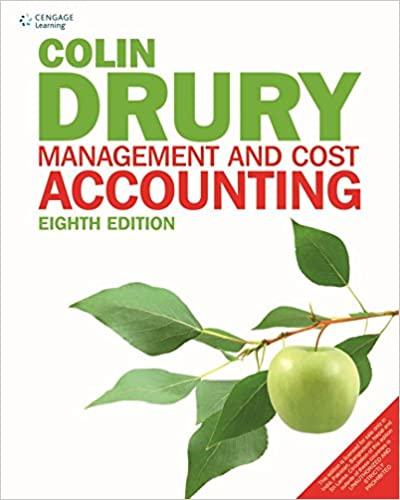The Rubber Group (TRG) manufactures and sells a number ol rubberbased products. Its strategic focus is channelled
Question:
The Rubber Group (TRG) manufactures and sells a number ol rubberbased products. Its strategic focus is channelled through profit centres which sell products transferred from production divisions that are operated as cost centres. The profit centres are the primary value-adding part of the business, whose commercial profit centre managers are responsible for the generation of a contribution margin sufficient to earn the target return of TRG. The target return is calculated after allowing for the sum of the agreed budgeted cost of production at production divisions, plus the cost of marketing, selling and distribution costs and central services costs.
The Bettamould Division is part of TRG and manufactures moulded products that it transfers to profit centres at an agreed cost per tonne. The agreed cost per tonne is set following discussion between management of the Bettaniould Division and senior management of TRG.
The following information relates to the agreed budget for the Bettamould Division for the year ending 30 June 2009:
1 The budgeted output of moulded products to be transferred to profit centres is 100 000 tonnes. The budgeted transfer cost has been agreed on a two-part basis as follows:
(i) A standard variable cost of \($200\) per tonne of moulded products;
(ii) A lump sum annual charge of \($50\) 000 000 in respect of fixed costs, which is charged to profit centres, at \($500\) per tonne of moulded products.
2 Budgeted standard variable costs (as quoted in 1 above) have been set after incorporating each of the following:
(i) A provision in respect of processing losses amounting to 15% of material inputs. Materials are sourced on a JIT basis from chosen suppliers who have been used for some years. It is felt that the 15% level of losses is necessary because the ageing of the machinery will lead to a reduction in the efficiency of output levels.
(ii) A provision in respect of machine idle time amounting to 5%. This is incorporated into variable machine costs.
The idle time allowance is held at the 5% level partly through elements of ‘real-time’ maintenance undertaken by the machine operating teams as part of their job specification.
3 Quality checks are carried out on a daily basis on 25% of throughput tonnes of moulded products.
4 All employees and management have contracts based on fixed annual salary agreements. In addition, a bonus of 5% of salary is payable as long as the budgeted output of 100 000 tonnes has been achieved;
5 Additional information relating to the points in (2) above (but NOT included in the budget for the year ending 30 June 2009) is as follows:
(i) There is evidence that materials of an equivalent specification could be sourced for 40% of the annual requirement at the Bettamould Division, from another division within TRG which has spare capacity.
(ii) There is evidence that a move to machine maintenance being outsourced from a specialist company could help reduce machine idle time and hence allow the possibility of annual output in excess of 100 000 tonnes of moulded products.
(iii) It is thought that the current level of quality checks (25%
of throughput on a daily basis) is vital, although current evidence shows that some competitor companies are able to achieve consistent acceptable quality with a quality check level of only 10% of throughput on a daily basis.
The directors of TRG have decided to investigate claims relating to the use of budgeting within organizations which have featured in recent literature. A summary of relevant points from the literature is contained in the following statement ‘The use of budgets as part of a ‘performance contract’ between an organization and its managers may be seen as a practice that causes management action which might lead to the following problems:
(a) Meeting only the lowest targets
(b) Using more resources than necessary
(c) Making the bonus — whatever it takes
(d) Competing against other divisions, business units and departments
(e) Ensuring that what is in the budget is spent
(f) Providing inaccurate forecasts (g) Meeting the target, but not beating it (h) Avoiding risks,’
Required:
(a) Explain the nature of any SIX of the eight problems listed above relating to the use of budgeting;
(b) Illustrate EACH of the six problems chosen in (a) using the data from the Bettamould division TRG scenario; and (c) Suggest ways in which each of the six problems chosen in (a) above may be overcome.
Step by Step Answer:






